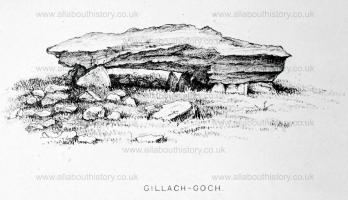Text this colour links to Pages. Text this colour links to Family Trees. Text this colour are links that are disabled for Guests.
Place the mouse over images to see a larger image. Click on paintings to see the painter's Biography Page. Mouse over links for a preview. Move the mouse off the painting or link to close the popup.
Garn Gilfach Burial Chamber is in Strumble Head, Pembrokeshire, Prehistoric Wales Neolithic Burials.

Archaeologia Cambrensis 1872 Pages 81-143. Proceeding onwards, towards Strumble Head, the cromlech-hunter will find one [Garn Gilfach Burial Chamber [Map]] at a place called in the Ordnance Map Gilfuch Goch, a view of which will be found in the Plates. It is of unusual character in having its capstone supported on a row of low stones,—so low that none but a very slender man, lying flat on the ground, could insinuate himself underneath. The capstone is nearly 14 ft. long, 8 wide, and 2 ft. thick, while all around are lying the relics of the former carn or tumulus. Mr. Blight did succeed in getting under the stone, but found only a fragment, of flint, which must have been placed there, as there is no natural flint in the country. It is also difficult to imagine how this grave could have been available for secondary interments, as the usual means of access to the interior do not exist. The following is Fenton's account, whose measurements do not exactly agree with those given above: "There is one more remarkable than the rest,—a large, unshapen mass of serpentine, 15 ft. by 8, and 2½ thick. Under the edges of it are placed nine or ten small, pointed, upright stones embedded in a strong pavement extending for some way round. These small supporters are seemingly fixed without any regard to their height, as only two or three bear the whole weight of the incumbent stone, one of which is so pressed by it as to have become almost incorporated with it. On the upper surface of the cromlech are three considerable excavations, near the centre; probably intended to have received the blood of the victim, or water for purification, if (as is the most general opinion) they were used as altars. Its height from the ground is very inconsiderable, being scarce one foot high on the lowest side; and on the other only high enough to admit of a person creeping under it, though when once entered the space enlarges from the upper stone, having a considerable concavity. The earth below is rich and black" (which he afterwards ascertained was chiefly the result of fire, as many bits of charcoal and rude pottery have been picked up there). A farmer informed Mr. Fenton that two or three years before his visit two spear-heads were found, laid across each other, and a knob of metal, suspected to have been gold.
![]() Become a Member via our Buy Me a Coffee page to read complete text.
Become a Member via our Buy Me a Coffee page to read complete text.